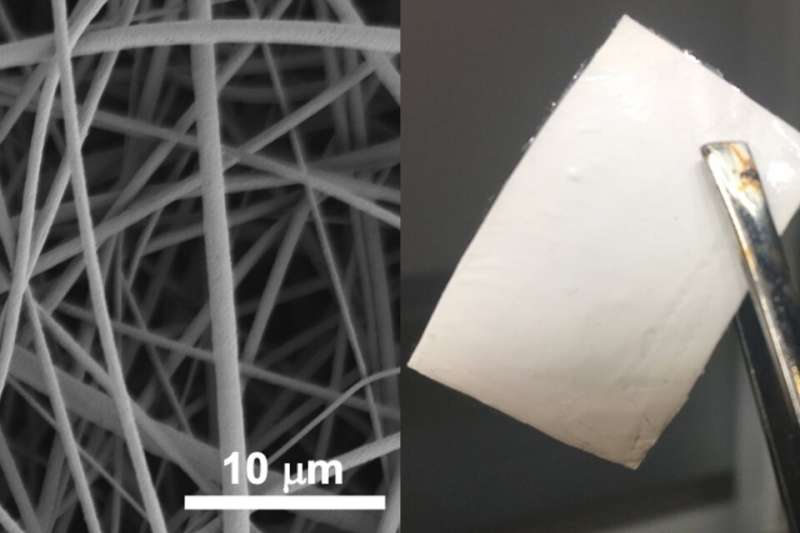
A team of researchers from the George Washington University School of Engineering and Applied Science has spent the past two years developing electrospun nanofiber fabrics for masks and air filters designed to sift out and neutralize the COVID-19 virus, generating significant research findings that could slow transmission as the pandemic wears on.
The research team was led by Danmeng Shuai, a SEAS associate professor of civil and environmental engineering who works in electrospinning, a manufacturing technique for generating ultrafine fibers, and Yun Shen, an assistant professor of chemical and environmental engineering at the University of California, Riverside, who is an environmental microbiologist and bioaerosol scientist. They received a $200,000 Rapid Response Research grant (RAPID) from the National Science Foundation in 2020 to develop ways in which electrospun nanofibers could be used to filter airborne COVID-19 viruses in personal protective equipment and industrial or residential HVAC systems.
Together with then-SEAS doctoral student Hongchen Shen, Ph.D. ’22, and current doctoral students Zhe Zhou and Jiahao Chen, they published three academic papers over the course of two years.
The first paper, published last year, compared the effectiveness of surgical and commercially available cotton masks, neck gaiters and electrospun nanofiber membranes at removing coronavirus aerosols to impede airborne transmission. Researchers used an animal coronavirus strain to simulate SARS-CoV-2 aerosolization to test the masks and membranes in a secure biosafety research lab at the GW School of Medicine and Health Sciences (SMHS)—a critical resource for the success of this project, Shuai said. Robert Miller, SMHS vice dean for research and academic affairs, Mariel Jais, director of the office of lab safety, and Molly Karl, lab manager, were all instrumental to this laboratory research. The team also used the GW Nanofabrication and Imaging Center’s imaging suite to characterize nanofiber size, shape and structure.
Electrospun air filters captured up to 99.9% of coronavirus aerosols, the researchers found—significantly outperforming many commercial face masks. Shuai has collaborated with an industry partner to develop a mask using this material.
“Fewer people are wearing masks nowadays, but interventions like wearing a mask or using really good air filters are still one of the best ways to control the spread of infectious diseases,” Shuai said.
The research group’s second paper, published in March, revealed how photosensitized electrospun nanofibrous membranes were fabricated to effectively capture and inactivate coronavirus aerosols and droplets, addressing the challenge of airborne transmission. Researchers observed in the lab that by adding an already-available chemical dye called rose bengal to the materials, more than 97% of virus-laden droplets could be inactivated after only 15 minutes of exposure under a regular desk lamp.
Photosensitized electrospun nanofibrous membranes able to capture and kill airborne environmental pathogens under ambient conditions hold promise for broad applications as personal protective equipment and indoor air filters, the paper surmises.
“At the beginning of the pandemic, masks were always limited, and frontline health care workers were trying to reuse and recycle N95 masks. They had to find very creative ways—using heat, using hydrogen peroxide vapor—but these were all complicated and required special equipment,” Shuai said. “With our material, we were thinking, how we can potentially reuse and recycle a mask under ambient conditions.”
The third paper, published in March, is a perspective that reviews the comprehensive understanding of status and challenges of electrospinning for air filtration, and explores future nanomaterial and protocol development for controlling airborne viruses, preventing the spread of infectious diseases, and beyond. The paper calls for establishing standardized protocols for evaluating the electrospun nanofibrous membranes’ performance for removing viral aerosols. Hongchen Shen was also a lead author on this paper.
“Many people are doing similar work, but there is not a standard of protocol,” Shuai said. “It is as if people are speaking in different languages and there’s no translator in between, it’s really hard to compare.”
Source: Read Full Article